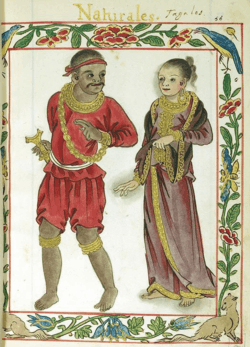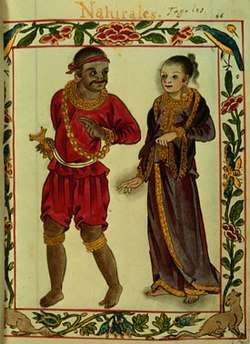Lakan
In early Philippine history, the rank of Lakan denoted a "paramount ruler" (or more specifically, "paramount datu") of one of the large coastal barangays (known as a "bayan") on the central and southern regions of the island of Luzon.[1]
| Pre-Colonial History of the Philippines |
 |
|---|
| Barangay government |
| Ruling class (Maginoo): Datu (Lakan, Raja, Sultan) |
| Middle class: Timawa, Maharlika |
| Serfs, commoners and slaves (Alipin): Horohan, Alipin Namamahay, Alipin sa gigilid, Bulisik, Bulislis |
| The book of Maragtas |
| States in Luzon |
| Caboloan (Pangasinan) |
| Ma-i |
| Rajahnate of Maynila |
| Namayan |
| Tondo |
| States in the Visayas |
| Kedatuan of Madja-as |
| Kedatuan of Dapitan |
| Kingdom of Mactan |
| Rajahnate of Cebu |
| States in Mindanao |
| Rajahnate of Butuan |
| Sultanate of Sulu |
| Sultanate of Maguindanao |
| Sultanates of Lanao |
| Key figures |
|
| History of the Philippines |
| Portal: Philippines |

Overview
The lakan was democratically selected by other ruling datus from among themselves to serve as their "pangulo" (head).[2] Writers such as William Henry Scott have suggested that this rank is equivalent to that of Rajah, and that different ethnic groups either used one term or the other, or used the two words interchangeably.[3][4] But other writers such as Nick Joaquin have suggested that the usage of the term "Rajah" specifically indicates leadership of a bayan or barangay which has extensive trade relations with Muslim traders.[2][5] Equivalent terms for this rank include the term "Sultan" among the most developed and complex Islamized principalities of Mindanao, and the term "Datu" as used by various polities in the Visayas and in some areas of Mindanao.[6]
Orthography and similar terms
The title Lakan can be spelled separately from a person's name (e.g. "Lakan Dula"), or can be incorporated into a singly spelled word (e.g. "Lakandula").
Rajah and Lakan: It is sometimes argued that since the words Rajah and Lakan mean more or less the same thing, the two should not be used together. Thus, popular reference to Rajah Lakan Dula are said to be the result of mistaking Lakan Dula to be the full proper name of the historic king.[4]
Prominent Lakans
Users of the title Lakan that figure in 16th- and 17th-century Spanish colonial accounts of Philippine history include:
Present-day usage
In present-day culture, the term is still occasionally used to mean "nobleman", but has mostly been adapted to other uses.
The name of Malacañan Palace, the official residence of the President of the Republic of the Philippines, is traditionally attributed to the phrase may lakan diyan, or "the king [or head] resides there".[7]
In Filipino Martial Arts, Lakan denotes an equivalent to the black belt rank.[8] Also, beauty contests in the Philippines have taken to referring to the winner as "Lakambini", the female equivalent of Lakan. In such cases, the contestant's assigned escort can be referred to as a Lakan. More often, a male pageant winner is named a Lakan.[9]
See also
- Principalía
- Maginoo
- Datu
- Maharlika
- Timawa
- Philippine shamans
- Tondo (historical polity)
- Barangay
- History of the Philippines (pre-1521)
Sources
- "Pre-colonial Manila". Malacañang Presidential Museum and Library. Malacañang Presidential Museum and Library Araw ng Maynila Briefers. Presidential Communications Development and Strategic Planning Office. 23 June 2015. Archived from the original on 9 March 2016. Retrieved 27 April 2017.
- Jocano, F. Landa (2001). Filipino Prehistory: Rediscovering Precolonial Heritage. Quezon City: Punlad Research House, Inc. ISBN 971-622-006-5.
- Scott, William Henry, Barangay: Sixteenth-Century Philippine Culture and Society, Quezon City: Ateneo de Manila University Press, 1994.
- Laput, Ernesto J. (2004-08-16). "PINAS: Buhay Sa Nayon". Mga Kasaysayan Ng PINAS: A Web of Philippine Histories. Archived from the original on 2004-08-16. Retrieved 2017-06-29.(in Tagalog)
- Joaquin, Nick (1990). Manila, My Manila: A History for the Young. City of Manila: Anvil Publishing, Inc. ISBN 978-971-569-313-4.
- Junker, Laura Lee (1998). "Integrating History and Archaeology in the Study of Contact Period Philippine Chiefdoms". International Journal of Historical Archaeology. 2 (4).
- Ocampo, Ambeth (1995). "Inside Malacañang". Bonifacio's Bolo. Pasig City: Anvil Publishing Inc. p. 122. ISBN 971-27-0418-1.
- http://www.martialedge.net/encyclopedia/definition/terminology/view/lakan/%5B%5D
- http://www.oroquietacity.com/ArtCulture/Lakambini.html